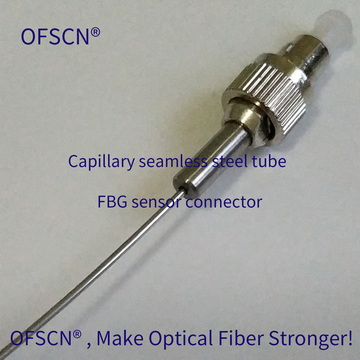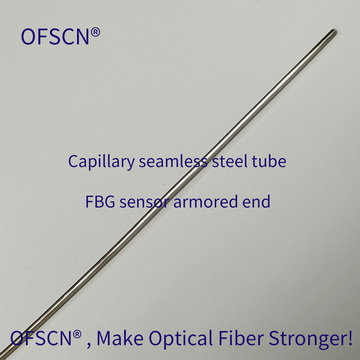This article introduces the working temperature range of the OFSCN® 100°C Capillary Seamless Steel Tube Fiber Bragg Grating (FBG) temperature sensor (FBG thermometer), including its maximum high-temperature endurance and maximum low-temperature values. It also describes the methods and principles for determining the working temperature range of fiber bragg grating temperature sensors (including the stainless steel materials used and the FBG written using ultraviolet lithography).
The working temperature range of fiber bragg grating sensors is primarily determined by the fiber bragg grating (FBG) and the sensor packaging materials. Therefore, analysis needs to be conducted from these two aspects.
1. Working Temperature Range of Packaging Material for OFSCN® 100-degree Celsius Capillary Seamless Steel Tube Fiber Bragg Grating Temperature Sensor (FBG Thermometer)
The OFSCN® 100°C Capillary Seamless Steel Tube Fiber Bragg Grating (FBG) temperature sensor developed by DCYS adopts a unique patented technology for stainless steel seamless tube packaging. Its structure is extremely simple, with no adhesive or other auxiliary materials. It is composed of only fiber bragg gratings (FBGs) and stainless steel seamless tubes. Therefore, determining its operating range only requires analyzing the fiber bragg gratings (FBGs) and stainless steel materials.
 |
 |
|
Figure 1 |
Figure 2 |
For the OFSCN® 100°C Capillary Seamless Steel Tube Fiber Bragg Grating (FBG) temperature sensor, its long-term working temperature range is from -40°C to +100°C, and its short-term working temperature range is from -60°C to +120°C. Both of these temperature ranges are far below the temperature limits of the stainless steel material. Therefore, this temperature range is mainly determined by the coating material, polyacrylate, used on the fiber bragg grating (FBG).
2. Working Temperature Range of Femtosecond FBG for OFSCN® 100-degree Celsius Capillary Seamless Steel Tube FBG Temperature Sensor (FBG Thermometer)
 |
|
Figure 3 |
 |
| Figure 4 |
In the traditional telecommunications industry, if high-quality optical fibers are used, the temperature range for polyacrylate-coated fibers is generally from -40°C to +85°C.
The OFSCN® 100°C Capillary Seamless Steel Tube Fiber Bragg Grating (FBG) temperature sensor uses Corning SMF-28e fiber, and its long-term working temperature range is determined to be from -40°C to +100°C, with a short-term working temperature range from -60°C to +120°C. It can be repeatedly used at temperatures up to +120°C (continuous use in a +100°C environment). It should be noted that the above temperature ranges provide measured values for the high-temperature portion and theoretical values (not reaching the limits) for the low-temperature portion.
 |
| Figure 5 |
Our philosophy is: "OFSCN®, make optical fiber stronger!"
